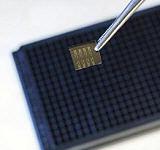
COE researchers are striving to replace microplates (tiny test tubes used to test multiple samples) with Microelectronics technology. This new biosensing technology, if applied properly, can make a “real time disease diagnosis” in a doctor’s office a reality, by electronically detecting certain markers that can identify healthy and unhealthy cells.The multi-welled microplate, long a standard tool in biomedical research and diagnostic laboratories, could become a thing of the past. Fundamental to the new biosensing system is the ability to electronically detect markers that differentiate between healthy and diseased cells. These markers could be differences in proteins, mutations in DNA or even specific levels of ions that exist at different amounts in cancer cells. Researchers are finding more and more differences like these that could be exploited to create fast and inexpensive electronic detection techniques that don't rely on conventional labels.
"We have put together several novel pieces of nanoelectronics technology to create a method for doing things in a very different way than what we have been doing," says Muhannad Bakir, associate professor of Electrical and Computer Engineering. "What we are creating is a new general purpose sensing platform that takes advantage of the best of nanoelectronics and three dimensional electronic system integration to modernise and add new applications to the old microplate application. This is a marriage of electronics and molecular biology."
The three-dimensional sensor arrays are fabricated using conventional low-cost, top-down microelectronics technology. Though existing sample preparation and loading systems may have to be modified, the new biosensor arrays should be compatible with existing work flows in research and diagnostic labs. A key advantage of the platform is that sensing will be done using low-cost, disposable components, while information processing will be done by reusable conventional integrated circuits connected temporarily to the array. Ultra-high density spring-like mechanically compliant connectors and advanced "through-silicon vias" will make the electrical connections while allowing technicians to replace the biosensor arrays without damaging the underlying circuitry.
